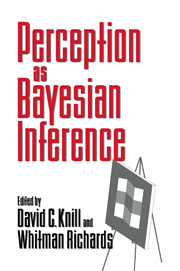Book contents
- Frontmatter
- Contents
- List of contributors
- Preface
- 0 Introduction
- Part one Bayesian frameworks
- 1 Pattern theory: A unifying perspective
- 2 Modal structure and reliable inference
- 3 Priors, preferences and categorical percepts
- 4 Bayesian decision theory and psychophysics
- 5 Observer theory, Bayes theory, and psychophysics
- Commentaries
- Part two Implications and applications
- Commentaries
- Author index
- Subject index
3 - Priors, preferences and categorical percepts
Published online by Cambridge University Press: 05 March 2012
- Frontmatter
- Contents
- List of contributors
- Preface
- 0 Introduction
- Part one Bayesian frameworks
- 1 Pattern theory: A unifying perspective
- 2 Modal structure and reliable inference
- 3 Priors, preferences and categorical percepts
- 4 Bayesian decision theory and psychophysics
- 5 Observer theory, Bayes theory, and psychophysics
- Commentaries
- Part two Implications and applications
- Commentaries
- Author index
- Subject index
Summary
Introduction
Visual perception is the process of inferring world structure from image structure. If the world structure we recover from our images “makes sense” as a plausible world event, then we have a “percept” and can often offer a concise linguistic description of what we see. For example, in the upper panel of Figure 3.1, if asked, “What do you see?”, a typical response might be a pillbox with a handle either erect (left) or flat (right). This concise and confident response suggests that we have identified a model type that fits the image observation with no residual ambiguities at the level of the description. In contrast, when asked to describe the two lower drawings in Figure 3.1, there is some hesitancy and uncertainty. Is the handle erect or not? Does it have a skewed or rectangular shape? The depiction leaves us somewhat uncertain, as if several options were possible, but none where all aspects of the interpretation collectively support each other. What then, leads us to the certainty in the upper set and to the ambiguity in the lower pair?
To be a bit more precise about our goal, let us assume that some Waltz-like algorithm has already identified the base of the pillbox and the wire-frame handle as separate 3D parts. Even with this decomposition, there remains an infinity of possible interpretations for any of these drawings.
Information
- Type
- Chapter
- Information
- Perception as Bayesian Inference , pp. 93 - 122Publisher: Cambridge University PressPrint publication year: 1996
Accessibility standard: Unknown
Why this information is here
This section outlines the accessibility features of this content - including support for screen readers, full keyboard navigation and high-contrast display options. This may not be relevant for you.Accessibility Information
- 25
- Cited by
